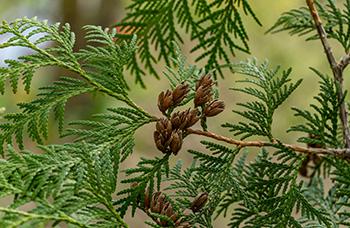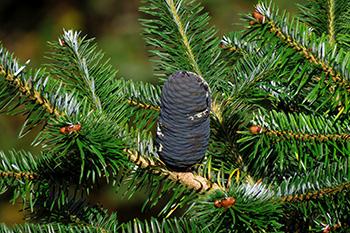
5 ‘Miracle Trees’ The Native Americans Used For Medicine
Native Americans have used herbs, trees, and plants for thousands of years to cure themselves as well as to purify their spirits and bring balance and harmony into their lives and surrounding areas. According to oral traditions, they learned about the medicinal properties of trees from watching sick animals obtain relief and then trying the leaves and bark for their own injuries and illnesses.
Today, there are 5 ‘miracle trees’ that continue to be used for medicinal purposes. They are highlighted below, along with their respective healing properties and recommended applications.
Balsam Fir
The balsam fir (Abies balsamea) has a pyramidal shape and smooth dark gray bark with resinous bubbles. Although it resembles spruce at first glance, the needles are flat instead of round like spruce needles. Round yellow male cones appear on the previous year’s growth, while purple female cones grow on the peak of the tree.
Among Native Americans, balsam fir has traditionally been used for the following healing purposes:
- Using resin in a salve to treat skin issues like burns, irritation, and ulcers.
 Making tea from the inner bark to treat symptoms of high blood sugar.
Making tea from the inner bark to treat symptoms of high blood sugar.- Making tea from chopped up branches and bark to treat colds, coughs, headaches, and chest pains.
- Applying resin to relieve toothaches.
- Boiling the needles and bark to create a decoction to relieve joint pain and muscle spasms.
Today, natural health practitioners recognize balsam fir’s antiseptic, antibiotic, and diuretic qualities. Syrup containing balsam fir resin is used to treat colds, the flu, and clear respiratory airways. Additionally, it helps scarring in wounds and treats stomach ulcers and aches.
To collect the resin for healing purposes, pierce the bubbles found on the bark. You can apply it directly on small cuts to staunch bleeding and even treat larger cuts on ‘awkward’ areas of the body where a plaster won’t stick. Smear or pour resin onto minor burns to form an antiseptic, air-tight seal that will lessen the pain associated with the burn.
Eastern White Cedar
Eastern white cedar (Thuja occidentalis) has a smooth bark that falls off in strips. Its leaves and wood are extremely aromatic, and its leaves form scale-like flat needles. Male greenish-yellow cones and female pink cones are visible along the branches.
Native Americans have traditionally used eastern white cedar’s medicinal properties in the following ways:
- Chewing or boiling the needles to treat colds and flus, coughs, headaches, fever, and chronic pain.
 Women in labor or suffering painful menstruation would also use it as an analgesic.
Women in labor or suffering painful menstruation would also use it as an analgesic.
- Making a decoction to treat toothaches, earaches, kidney problems, and colic.
- Making a powder from its rotting wood to treat skin irritation and itchiness.
Today, the widely-accepted medicinal properties of the eastern white cedar are antimicrobial, antioxidant, and immunostimulant. In herbalism, it is used to treat warts and other skin problems.
You can make a refreshing cup of cedar tea by putting one tablespoon of washed and chopped up needles into a mug and covering it with boiling water. Discard the needles as soon as the tea turns a golden brown and add honey or maple syrup to sweeten the taste. Consumption should be limited to around three cups of cedar tea per week, to avoid overdoing it.
Spruce – Black or White
Black spruce (Picea mariana) can be distinguished by its narrow peaks that often appear irregular. Its bark is dark and rough, and the needles are rounder. In contrast, white spruce (Picea glauca) has a pyramid-shaped peak with longer needles, although these needles are also round.
The Native Americans put the black and white spruce trees to work in the following ways:
- Chewing the young spruce cones to relieve cough, sore throats, and diarrhea.
- Consuming the edible inner bark to treat colds and flus
- Boiling chopped branches to create a decoction for treating headaches, stomach aches, and arthritis
Both spruce varieties have a resin with antimicrobial and antibacterial properties. Native Americans mixed it with animal grease to treat skin irritation, cuts, burns, and mosquito bites.
You can use it to treat wounds even today as well as chew it to fortify yourself against the cold and flu. When added to bath salts, spruce resin enhances their relaxing properties.
To make a cup of spruce needle tea (which also happens to be high in Vitamin C), cut the needles off the branch and place a tablespoon full at the bottom of a mug. Pour boiling water over the needles, steep for five minutes, and then strain and serve. For an extra infusion of warm flavor, add a cinnamon stick.
Tamarack Larch
In the Algonquin language, tamarack refers to wood which is used to make snowshoes. The tamarack larch (Larix laricina) is distinguished by its scaly gray bark with a reddish tint. When young, the tree’s shape is conical, but at maturity it grows into an ovoid shape. Larch needles are long and soft, growing up to 6cm in length.

Native Americans had several medicinal uses for tamarack larch. They include but are not limited to:
- Drying and powdering the bark to treat wounds that weren’t healing properly.
- Boiling the inner bark to create a tea that lowers blood sugar levels and treats bleeding gums, sore throats, and coughs.
Today, tamarack larch is an ingredient in remedies used to fight colds, flus, and stomach ulcers. When mashed up and applied to burned or infected skin, the soft inner bark can heal infections and soothe burn pain.
To make what the Ojibwe people called mshkiigwaatikohns tea, place one cup of bark pieces and twigs into a five liter pot filled with water. Put a lid on and simmer for an hour. Immediately after simmering, remove from heat and strain at least twice to ensure all fine particles are removed. Put the strained tea into a container, cool it down to the desired drinking temperature, and enjoy!
Paper Birch
 Paper birch (Betula papyrifera) bark is white with beige horizontal streaks that peel back and shed naturally. Its young twigs are reddish colored and its oval leaves are sharply pointed.
Paper birch (Betula papyrifera) bark is white with beige horizontal streaks that peel back and shed naturally. Its young twigs are reddish colored and its oval leaves are sharply pointed.
The sap, bark, and buds are harvested when spring begins while the leaves are harvested from June to September.
Native Americans used paper birch sapwood to eliminate toxins, soothe headaches, control menstrual bleeding, and stop wound bleeding by inducing coagulation. Decayed birch wood was mixed with labrador tea and powdered to treat skin irritation. Today, it’s used in natural remedies as an astringent, diuretic and anti-inflammatory ingredient.
If you live in an area where paper birch trees are abundant, you can tap them for syrup the same way maple trees are tapped. It takes 25 gallons of sap to make one liter of birch syrup, which is why it commands such high prices. Making your own can save a lot of money!
The ‘miracle trees’ in this article are only a few examples of those that the Native Americans used to treat different illnesses. Their wisdom has not been forgotten: many modern remedies and medicines are derived from the Native American knowledge of plants, herbs, and in this case, trees.
You may also like:
 The Killer Tree You Should Never Have In Your Backyard
The Killer Tree You Should Never Have In Your Backyard
What You Should Do Immediately When You Find An Alligator Tree? (Video)
How to Identify the Ginkgo Biloba Tree: Does It Grow on Your Street?








 Making tea from the inner bark to treat symptoms of high blood sugar.
Making tea from the inner bark to treat symptoms of high blood sugar.


love this
GooD information always
It would be beneficial for notes on WHERE each type of tree is found.:
Abies balsamea or balsam fir is a North American fir, native to most of eastern and central Canada (Newfoundland west to central Alberta) and the northeastern United States (Minnesota east to Maine, and south in the Appalachian Mountains to West Virginia).
Eastern White Cedar native to eastern Canada and much of the north-central and northeastern United States.
Black spruce is native to northern North America, from Newfoundland to Alaska, Pennsylvania, Minnesota and central British Columbia.
Picea glauca (White Spruce) is native from central Alaska all through the east, across southern/central Canada to the Avalon Peninsula in Newfoundland, and south to Montana, Minnesota, Wisconsin, Michigan, Vermont, New Hampshire, New York and Maine;
Tamaracks grow widely in Newfoundland, Minnesota, West Virginia, Montana, and Wisconsin.
Paper Birch hardiness zone 2-6
So, In other words, YOUR area, but not the Pacific Northwest. How about being clear on WHICH Native Americans you are referencing? Or, better yet, including ALL native Americans, one tree for each area?
The article should’ve said it was aimed for the North-Eastern U.S. with very little variance and nothing for the Western U.S.
The exception imho is Paper Birch tree, I have seen those here in California, not sure if they’re native, though.
Most people won’t tell you exact location and there’s a reason for that. Because then everyone would go harvest them without any thoughts of how that puts many plants at risk as it has already for a number of plants and trees.
Just a friendly reminder. Only harvest 1/3 of plants. That’s roughly 1 plant per 10 plants! And if you’re wild harvesting, make sure to go back out and spread the seeds of the plants you’re taking from its habit! If you take, you must give back.
I like this article
But the videos!!?? Please, please, pretty please, give me the text available (I am deaf, and don’t want to view an extended marketing video that I cannot shut off when I need to…)
Good point. And why are all of the “short videos” SO LONG. Just cut to the chase please.
Sorry. Wasn’t referring specifically to your videos, I was referring to all of the promotional videos online. They all claim a “short video”. NONE ARE.
How about recipes?
The book doesn’t have them either.
I understand the purpose of this article is information about the trees and that’s what I got from it. I really enjoyed; something I didn’t know. I didn’t expect to find geographic or historic information. If I want that, then I get my self an encyclopedia or take a run to the library. Thank you for the valuable information. I appreciate it.